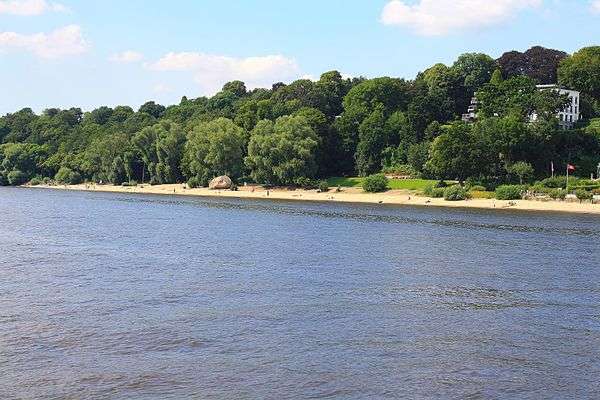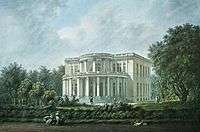Elbchaussee
The Elbchaussee (German pronunciation: [ˈɛlb ʃɔˈseː]) is a famous thoroughfare of Hamburg, Germany, joining the city's western Elbe suburbs (Elbvororte) Othmarschen, Nienstedten and Blankenese with Altona and Hamburg's inner city. Running along the elevated northern Elbe shore, across Geest heights, embedded forests and meadows, the Elbchaussee offers scenic views across the widening Lower Elbe, onto the opposite plains of Altes Land, and the distant activities of the port's container terminals.
Elbchaussee is best known for its many stately homes and villas, framed by ancient trees and lush parks and gardens. Developed as a residential road in the 18th century, at times also center of a local recreational area, Elbchaussee today is still home to many of Hamburg's finest residences, restaurants and hotels. At a length of 8.6 kilometers (5.3 miles) and a traffic volume of 40,000 cars per day, it also covers functions as a local collector road and one of Hamburg's arterial roads.
History
Since the time after the Thirty Years War (1618–1648), the area had a few country estates and summer retreats connected by a bumpy country lane. During the second half of the 18th century, with more Hamburg Grand burghers, wealthy merchants and ship-owners establishing their homes along the Elbe shore, Elbchaussee became a fashionable residential address. Around 1780, and on private initiative, the street was enhanced as a chaussée and managed as a exclusive toll road.[1][2][3]


The years between 1790 and 1840 saw a building boom on Elbchaussee. Villas and country houses from those years are identifiable by being named after the respective commissioning Hanseatic first families, and many of them likened to Royal residences.[4] Typical for late 18th-century and early 19th-century European architecture, most of them were built in Neoclassical or Biedermeier style, surrounded by parks often inspired by English landscape design. During the Gründerzeit years (ca. 1871–1900), other building styles were also applied, including various Revival styles, Art Deco and Art Nouveau (Jugendstil).
With completion of modern infrastructure projects in the second half of the 19th century, the Elbchausee became popular as a local recreational area. On weekends and bank holidays, the new railway, tram and ferry lines brought large crowds to the Elbchaussee and its beaches.[5] In the 1890s the management of the promenade was transferred to municipal authorities.
The Elbe suburbs were merged into the town of Altona in 1927, which in turn was merged into the city of Hamburg in 1937. As recent as 1950, a renaming of the eastern half was carried out.[6] Despite forming a unity in terms of both traffic and a landscaped urban space all along, the street's eastern half was until then called "Flottbecker Chaussee" or "Flottbeker Chaussee", only the western half "Elbchaussee".[notes 1] Since the 1990s a number of villas of the fin de siècle have been replaced by high end apartment buildings, mainly New Classical or Modern architecture.
Route description

B = Blankenese Pier, T = Teufelsbrück Pier, N = Neumühlen/ Oevelgönne Pier
Within its length of 8.6 kilometers (5.3 miles), Elbchaussee is a rather heterogeneous street.
At its eastern end, Elbchaussee starts hardly noticeable as an extension of Altona's Palmaille and Klopstockstraße. The first public park to the left is Heine-Park, laid out as an English park in the late 18th century. Subsequent parks are Donner's Park and Rosengarten. These green spaces all have interconnecting perrons and stairways down to Neumühlen at the Elbe's shore. Neumühlen has a quay wall, then from the Neumühlen/Oevelgönne Ferry Pier onwards, the Oevelgönne shore has a natural sand beach. The section of Elbchaussee up to Teufelsbrück Ferry Pier features a homogenous allocation of villas on both street sides, with the exceptions of Schröder's Elbpark and Hindenburgpark.
Teufelsbrück Ferry Pier, including a small marina, are located at the mouth of the Flottbek creek. At this point, Elbchaussee leaves the elevated plateau of the Geest, and briefly comes down close to the river shore. Opposite of Teufelsbrück, the Elbchaussee passes the Flottbek Valley, landscaped into Jenisch park, at 42 hectare by far the largest of the Elbe parks. For the next one and a half kilometers, Elbchaussee runs close to the river. At Louis C. Jacob's Hotel, it leaves the Elbe shore and turns inland. After passing the rather large Hirschpark, the Elbchaussee winds into the narrow street net of Blankenese, finding its western end in continuation of Blankeneser Hauptstraße, not far off the Süllberg or Blankenese Ferry Pier.
Elbe parks
Many of the now public Elbe parks (Elbparks) used to be massive private properties.

| Name | Size | Location |
|---|---|---|
| Heine-Park | 3.4 ha[7] | Elbchaussee 31–45 |
| Donner's Park | 4.3 ha[7] | Elbchaussee |
| Rosengarten & Liebermannpark | Elbchaussee | |
| Schröder's Elbpark | Elbchaussee | |
| Hindenburgpark | Elbchaussee | |
| Jenisch-Park | 42.0 ha[7] | Elbchaussee |
| Nienstedten Cemetery | 10.5 ha[7] | Elbchaussee |
| Hirschpark | 24.5 ha[7] | Elbchaussee |
| Baur's Park | 8.7 ha[7] | Elbchaussee |
Notable premises
There are over 500 properties on Elbchaussee, approximately one fourth listed as cultural heritage monuments. The house numbering system follows a European scheme, with odd numbers for lots facing the Elbe, and even numbers for the opposite lots.
| Name | Built | Location (address) | Notes on present owner, tenant or usage |
|---|---|---|---|
| Heinrich-Heine-Haus | 1832 | Elbchaussee 31 | branch of Altona Museum |
| Villa Plange (Villa im Heine-Park) | 1913 | Elbchaussee 43 |  Hamburg Business Club |
| 1989 | Elbchaussee 139 | Gerkan, Marg and Partners | |
| Villa Brandt (Säulenhaus) | 1817 | Elbchaussee 186 |  Villa Brandt (Säulenhaus) |
| Halbmondhaus | 1796 | Elbchaussee 228 | |
| Villa de Freitas | 1904 | Elbchaussee 239 | Villa de Freitas |
| 1907 | Elbchaussee 268 | Chinese Consulate General | |
| Park-Hotel | 1886 | Elbchaussee 279 | Das Weisse Hotel an der Elbchaussee |
| Jenisch-Haus | 1834 | Baron-Voght-Straße 50 | branch of Altona Museum |
| Fährhaus | Elbchaussee 322 | Restaurant "Im Fährhaus" | |
| Villa Schröder | 18?? | Elbchaussee 354 | International Tribunal for the Law of the Sea (ITLOS) |
| Landhaus Baur (Elbschlösschen) | 1806 | Elbchaussee 372 |  Hermann Reemtsma Stiftung |
| Nienstedten Church | 1751 | Elbchaussee | |
| 1765 | Elbchaussee 401–403 |  Lindenterrasse by Liebermann | |
| Landhaus J. C. Godeffroy | 1792 | Elbchaussee 499 |  Landhaus J. C. Godeffroy |
| Landhaus P. Godeffroy | 1792 | Elbchaussee 547 |
Notes
- ↑ in older spelling also Elb-Chaussee; Elbchaussee is a German language portmanteau consisting of the words "Elbe" and "Chaussee".
References
- ↑ Hoffmann, Paul Theodor (1982). Die Elbchaussee: ihre Landsitze, Menschen und Schicksale (in German). Hamburg: Broschek. ISBN 3767204967.
- ↑ Douglas, Amrine (2014). DK Eyewitness Travel Guide: Hamburg. London: Dorling Kindersley Ltd. p. 118. ISBN 1409351378. Retrieved 14 May 2015.
- ↑ Höhne, Wieland (2013). Baedeker Reiseführer Hamburg (in German). Ostfildern: Baedeker Verlag. pp. 183 f. Retrieved 11 May 2015.
- ↑ Berger, Julia (2003). "In the Valley of Kings:Classicist Architecture in Hamburg, Altona and the Elbvororte (1790–1840)". Patriotism, Cosmopolitanism, and National Culture: Public Culture in Hamburg 1700-1933. Amsterdam: Rodopi. pp. 115 ff. Retrieved 14 May 2015.
- ↑ "Die Elbchaussee". nienstedten.de (in German). Förderverein der Freiwilligen Feuerwehr Nienstedten e.V. Retrieved 14 May 2015.
- ↑ "Nur noch Eibchaussee [sic]" (in German). Hamburger Abendblatt. 14 June 1950. Retrieved 14 May 2015.
- 1 2 3 4 5 6 "Elbe³ Erholen. Entdecken. Erleben!" (PDF). hamburg.de (in German). Freie und Hansestadt Hamburg, Behörde für Stadtentwicklung und Umwelt (BSU). Retrieved 14 May 2015.
External links
![]() Media related to Elbchaussee at Wikimedia Commons
Media related to Elbchaussee at Wikimedia Commons
![]() Media related to Elbe in Altona at Wikimedia Commons
Media related to Elbe in Altona at Wikimedia Commons
- photos on bilderbuch-hamburg.de (German)